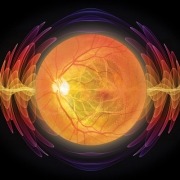
The second Biennial International Symposium on Ocular Regeneration brought together leaders in the fields of ophthalmology, genetics, stem cell biology, neuroregeneration, and neuroremodeling who aim to accelerate cures for blinding diseases. The event, held October 20, 2016 in Boston, MA, drew nearly 200 researchers, clinicians, trainees, and industry representatives from around the world.

 A cornerstone of the event was the keynote address, which was delivered by John Dowling, PhD, Harvard University, an expert on the neural architecture of the retina. His talk, Reconstructing the Human Fovea, stressed the importance of the fovea— part of the eye responsible for sharp, central vision. “If we are ever going to be able to restore high-acuity vision through regenerative medicine, it is critical for us to know about the fovea,” said Dr. Dowling before detailing work he performed in his “postdoctoral fellowship”—an endeavor he has undertaken since his formal retirement in 2015.
A cornerstone of the event was the keynote address, which was delivered by John Dowling, PhD, Harvard University, an expert on the neural architecture of the retina. His talk, Reconstructing the Human Fovea, stressed the importance of the fovea— part of the eye responsible for sharp, central vision. “If we are ever going to be able to restore high-acuity vision through regenerative medicine, it is critical for us to know about the fovea,” said Dr. Dowling before detailing work he performed in his “postdoctoral fellowship”—an endeavor he has undertaken since his formal retirement in 2015.
In a span of two years, the field of regenerative medicine has advanced significantly. As an example, in 2014, Harvard Ophthalmology initiated the first restorative human stem cell transplant in patients with age-related macular degeneration (AMD), which was discussed at the inaugural event. At this year’s Symposium, data on the first human induced pluripotent stem cell (iPS) transplants were presented. Additional topics in the evolving field of retinal repair and regeneration included gene therapy, neuronal loss, dysfunction and age-related damage, and stem cell therapy—all of which are promising avenues for future potential treatments for degenerative eye diseases.
The event was presented in partnership with the fourth Biennial International Symposium on AMD and was sponsored by ReNeuron, the Beryl David and Harry N. Gorin Foundation, Alcon, and the National Institutes of Health.
